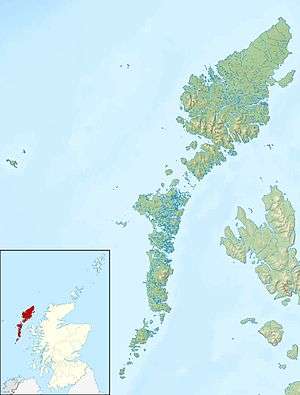Soay, St Kilda
| Gaelic name | Soaigh |
|---|---|
| Norse name | so-øy |
| Meaning of name | (Norse) "Sheep island" |
| Location | |
 Soay Soay shown within the Outer Hebrides | |
| OS grid reference | NA064014 |
| Physical geography | |
| Island group | St Kilda |
| Area | 99 ha (245 acres) |
| Area rank | 150= [1] |
| Highest elevation | Cnoc Glas 378 m (1,240 ft) |
| Administration | |
| Sovereign state | United Kingdom |
| Country | Scotland |
| Council area | Outer Hebrides |
| Demographics | |
| Population | 0 |
| References | [2][3][4] |
Soay (Scottish Gaelic: Soaigh) is an uninhabited islet in the St Kilda archipelago, Scotland. The name is from Old Norse Seyðoy, meaning "Island of Sheep". The island is part of the St Kilda World Heritage Site and home to a primitive breed of sheep. It is the westernmost point of land in Scotland, and also the westernmost point in the United Kingdom, excluding Rockall.
Geography
Soay lies some 40 miles (64 km) west-northwest of North Uist in the North Atlantic It is about 2 kilometres (1.2 mi) north-west of Hirta, from which it is separated by the narrow Sound of Soay, which is only about 500 metres wide. Two sea stacks, Stac Shoaigh (Soay Stac), 61 metres (200 ft), and Stac Biorach, 73 metres (240 ft), lie between. The island covers about 96.8 hectares (239 acres) and reaches a height of 378 metres (1,240 ft), the cliffs rising sheer from the sea.
The island is formed of a breccia of gabbro and dolerites and is a single mountain peak rising from the sea-bed, without Ice-Age erosion.[3]

Along with the rest of the archipelago, Soay is owned by the National Trust for Scotland, managed by Scottish Natural Heritage as a nature reserve and is included it the St Kilda World Heritage Site.[5] It is unlikely that this island ever had permanent habitation. Men from Hirta would stay for a few days while gathering wool.[6]
Wildlife
Feral Soay sheep are a relict population of the first sheep brought to northern Europe around 5000BC. They were kept for their wool, which was plucked, not shorn, and made into tweed.[7] Only occasionally were the sheep killed for meat.[3] When the neighbouring island of Hirta became uninhabited, Soay sheep were introduced there too, and more recently they have become widely kept elsewhere as a livestock animal. Another somewhat less primitive breed lives on another island in the group, the Boreray.
The island's cliffs hold breeding colonies of many seabirds, including gannet, fulmar, storm petrel, Manx shearwater, razorbill, great skua, Leach's petrel and puffin.
See also
- History of St Kilda
- List of outlying islands of Scotland
- Lítla Dímun, a similar island in the Faroes, formerly home to a similar breed of primitive sheep.
Footnotes
- ↑ Area and population ranks: there are c. 300 islands over 20 ha in extent and 93 permanently inhabited islands were listed in the 2011 census.
- ↑ 2001 UK Census per List of islands of Scotland
- 1 2 3 Haswell-Smith, Hamish (2004). The Scottish Islands. Edinburgh: Canongate. ISBN 978-1-84195-454-7.
- ↑ Ordnance Survey
- ↑ "World Heritage Sites Protected Areas Programme - St Kilda". Archived from the original on 2007-07-05. Retrieved 2007-07-22.
- ↑ "Soay Overview". Gazetteer for Scotland. Retrieved 2007-07-22.
- ↑ Haswell-Smith, Hamish (1996). The Scottish Islands. Canongate. p. 267. ISBN 0-86241-579-9.
Gallery
- Soay in mist
 Soay from Hirta
Soay from Hirta Soay and Hirta from Stac an Armin
Soay and Hirta from Stac an Armin Soay sheep
Soay sheep Steep pasture
Steep pasture Sound of Soay
Sound of Soay Soay in the mist
Soay in the mist Freshly fallen scree
Freshly fallen scree
| Wikimedia Commons has media related to Soay (St Kilda). |
Coordinates: 57°49′44″N 8°38′0″W / 57.82889°N 8.63333°W
